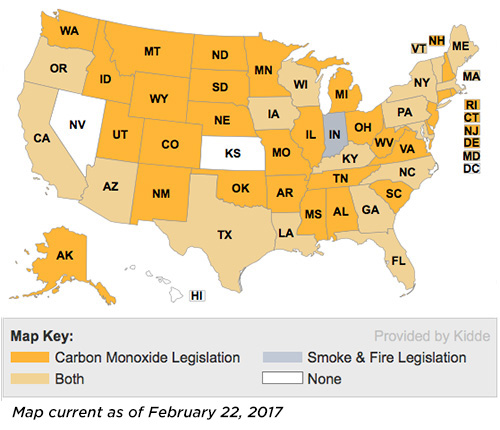
Carbon Monoxide
Often called "the silent killer," carbon monoxide (CO) is an odorless, tasteless, and invisible gas that is highly poisonous to humans and animals. This dangerous gas is produced any time fuel is burned in an appliance, grill, fireplace, furnace, small engine, or vehicle. In enclosed environments, such as an apartment, hospital room, office, garage, or workshop, exposure to carbon monoxide fumes can easily become lethal.
According to the CDC (Centers for Disease Control), carbon monoxide claims the lives of hundreds of people each year and makes thousands more ill. Because of the inherent danger of carbon monoxide poisoning, many states have legislation in effect to ensure the safety of its citizens. Keep your customers safe and your business compliant by being knowledgeable of carbon monoxide alarm legislation in your state.
Where Does Carbon Monoxide Come From?
Carbon monoxide is created when carbon-based fuels such as gasoline, propane, coal, or wood are burned in an area without adequate ventilation. This prevents the complete oxidation of carbon monoxide to carbon dioxide. In high concentrations, carbon monoxide can be fatal.
CO buildup can come from:
- Faulty furnaces, wood-burning stoves, portable propane stoves, and heaters
- Automobiles left idling in a garage or another enclosed space
- Gas appliances, including furnaces, fireplaces, stovetops, ranges, clothes dryers, hot water heaters, and gasoline-powered tools, and generators
Ways to Prevent CO Exposure
One way to prevent CO exposure is by properly installing a CO alarm. Be sure to inspect CO alarms at least twice a year, replacing batteries (if required), and looking for any signs of tampering. CO alarms should be checked at least twice per year and replaced at least every 10 years or as required by the manufacturer or state and local laws.
Types of Carbon Monoxide Alarms
Many types of carbon monoxide alarms are available, and when properly installed and maintained, all provide a warning when dangerous levels of carbon monoxide are detected. CO alarms should be certified by a national safety agency like UL (Underwriters Laboratories) and be battery-powered or have a battery back-up feature.
- Battery-Powered – the most basic of CO alarms and usually the most affordable. Batteries need to be tested at least twice a year to ensure the alarm is working properly.
- Hard-Wired – wired directly into the building's electrical grid, hard wired CO alarms require less monitoring than battery-only CO Alarms. For alarms that work even during an electrical outage, choose hard-wired alarms with sealed battery backups.
- DC Plug-In – Plug-In CO Alarms require less monitoring than battery-only CO alarms. For alarms that work even during an electrical outage, choose DC Plug-In alarms with battery backups.
Other features available include:
- ADA Compliant Voice Feature – select carbon monoxide alarms use a voice alert to indicate harmful carbon monoxide exposure. Our voice alert CO alarms are also ADA compliant.
- Combination Smoke & CO Alarm – get two notification systems in one when you choose a combination smoke and CO alarm. The same device that detects smoke also alerts occupants of harmful carbon monoxide.
- Digital Display – easy-to-read digital display shows exact levels of carbon monoxide and usually feature other alert functions.
Additional Ways to Prevent CO Exposure
According to the CDC, you can improve safety and help prevent carbon monoxide poisoning by doing the following:
- Routinely service all heating systems, water heaters as well as any gas, coal-burning, or oil appliances.
- When purchasing gas appliances, buy equipment certified by a nationally recognized testing agency.
- Ensure all gas equipment is properly vented. Vent pipes should be clean, snug-fitting, and venting uphill towards the exterior of the structure. Never patch a vent pipe.
- Chimneys should be serviced at least once a year to ensure they are free and clear of all debris.
- Generators should be operated outside - never in a basement or garage.
- Never use a gas range for heating.
- Never burn charcoal indoors.
- Never use a portable gas stove indoors, even if windows and doors are open.
- Never leave a vehicle or any other gas-powered equipment idling in garage or enclosed environment.
CO Alarm Legislation
Carbon monoxide can be deadly in just minutes if left undetected. Having working carbon monoxide alarms throughout your facility alerts everyone to potential danger. Many states have enacted carbon monoxide laws for the following property types:
- (R-1) Hotels and boarding houses
- (R-2) Apartments and dormitories
- (R-3) Adult and child daycare facilities
- (R-4) Residential units in high-rise buildings
- (L1) Hospitals, sanitariums, and mental institutions
- (L2) Infirmaries
- (L4) Facilities for hospital and healthcare staff
- Dwellings having a fuel burning appliance, fireplace or attached garage
- One and two-family dwellings and town homes of not more than three stories
These laws† may require your facility to have carbon monoxide alarms installed and routinely replaced. To avoid fines and stay compliant, check your state's statute and code language for the most updated information.
Find your state's legislation requirements. Select state to see its associated laws and legislation.

Additional Resources
†Alarm requirements vary by state. Consult individual statute for specific details.
NOTICE: This information is a summary interpretation and was prepared as general reference material only. This summary is not authoritative as laws can be amended over time. For specific compliance requirements and updates, please refer to the actual code language and the statute or consulting legal counsel.
